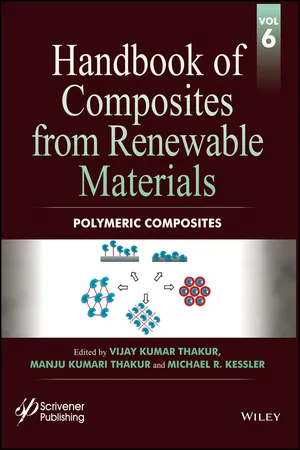
Handbook of Composites from Renewable Materials, Polymeric Composites
- English
- ePUB (mobile friendly)
- Available on iOS & Android
Handbook of Composites from Renewable Materials, Polymeric Composites
About this book
This unique multidisciplinary 8-volume set focuses on the emerging issues concerning synthesis, characterization, design, manufacturing and various other aspects of composite materials from renewable materials and provides a shared platform for both researcher and industry.
The Handbook of Composites from Renewable Materials comprises a set of 8 individual volumes that brings an interdisciplinary perspective to accomplish a more detailed understanding of the interplay between the synthesis, structure, characterization, processing, applications and performance of these advanced materials. The Handbook comprises 169 chapters from world renowned experts covering a multitude of natural polymers/ reinforcement/ fillers and biodegradable materials.
Volume 6 is solely focused on the " Polymeric Composites ". Some of the important topics include but not limited to: Keratin as renewable material for developing polymer composites; natural and synthetic matrices; hydrogels in tissue engineering; smart hydrogels: application in bioethanol production; principle renewable biopolymers; application of hydrogel biocomposites for multiple drug delivery; nontoxic holographic materials; bioplasticizer-epoxidized vegetable oils-based poly (lactic acid) blends and nanocomposites; preparation, characterization and adsorption properties of poly (DMAEA) – cross-linked starch gel copolymer in wastewater treatments; study of chitosan cross-linking hydrogels for absorption of antifungal drugs using molecular modelling; pharmaceutical delivery systems composed of chitosan; eco-friendly polymers for food packaging; influence of surface modification on the thermal stability and percentage of crystallinity of natural abaca fiber; influence of the use of natural fibers in composite materials assessed on a life cycle perspective; plant polysaccharides-blended ionotropically-gelled alginate multiple-unit systems for sustained drug release; vegetable oil based polymer composites; applications of chitosan derivatives in wastewater treatment; novel lignin-based materials as a products for various applications; biopolymers from renewable resources and thermoplastic starch matrix as polymer units of multi-component polymer systems for advanced applications; chitosan composites: preparation and applications in removing water pollutants and recent advancements in biopolymer composites for addressing environmental issues.
Frequently asked questions
- Essential is ideal for learners and professionals who enjoy exploring a wide range of subjects. Access the Essential Library with 800,000+ trusted titles and best-sellers across business, personal growth, and the humanities. Includes unlimited reading time and Standard Read Aloud voice.
- Complete: Perfect for advanced learners and researchers needing full, unrestricted access. Unlock 1.4M+ books across hundreds of subjects, including academic and specialized titles. The Complete Plan also includes advanced features like Premium Read Aloud and Research Assistant.
Please note we cannot support devices running on iOS 13 and Android 7 or earlier. Learn more about using the app.
Information
Chapter 1
Keratin as Renewable Material to Develop Polymer Composites: Natural and Synthetic Matrices
Abstract
1.1 Introduction
1.2 Keratin
Table of contents
- Cover
- Title page
- Copyright page
- Dedication
- Preface
- Chapter 1: Keratin as Renewable Material to Develop Polymer Composites: Natural and Synthetic Matrices
- Chapter 2: Determination of Properties in Composites of Agave Fiber with LDPE and PP Applied Molecular Simulation
- Chapter 3: Hydrogels in Tissue Engineering
- Chapter 4: Smart Hydrogels: Application in Bioethanol Production
- Chapter 5: Principle Renewable Biopolymers and Their Biomedical Applications
- Chapter 6: Application of Hydrogel Biocomposites for Multiple Drug Delivery
- Chapter 7: Non-Toxic Holographic Materials (Holograms in Sweeteners)
- Chapter 8: Bioplasitcizer Epoxidized Vegetable Oils–Based Poly(Lactic Acid) Blends and Nanocomposites
- Chapter 9: Preparation, Characterization, and Adsorption Properties of Poly(DMAEA) – Cross-Linked Starch Gel Copolymer in Wastewater
- Chapter 10: Study of Chitosan Cross-Linking Genipin Hydrogels for Absorption of Antifungal Drugs Using Molecular Modeling
- Chapter 11: Pharmaceutical Delivery Systems Composed of Chitosan
- Chapter 12: Eco-Friendly Polymers for Food Packaging
- Chapter 13: Influence of Surface Modification on the Thermal Stability and Percentage of Crystallinity of Natural Abaca Fiber
- Chapter 14: Influence of the Use of Natural Fibers in Composite Materials Assessed on a Life Cycle Perspective
- Chapter 15: Plant Polysaccharides Blended Ionotropically Gelled Alginate Multiple Unit Systems for Sustained Drug Release
- Chapter 16: Vegetable Oil-Based Polymer Composites: Synthesis, Properties and Their Applications
- Chapter 17: Applications of Chitosan Derivatives in Wastewater Treatment
- Chapter 18: Novel Lignin-Based Materials as Products for Various Applications
- Chapter 19: Biopolymers from Renewable Resources and Thermoplastic Starch Matrix as Polymer Units of Multi–Component Polymer Systems for Advanced Applications
- Chapter 20: Chitosan Composites: Preparation and Applications in Removing Water Pollutants
- Chapter 21: Recent Advances in Biopolymer Composites for Environmental Issues
- Index
- End User License Agreement